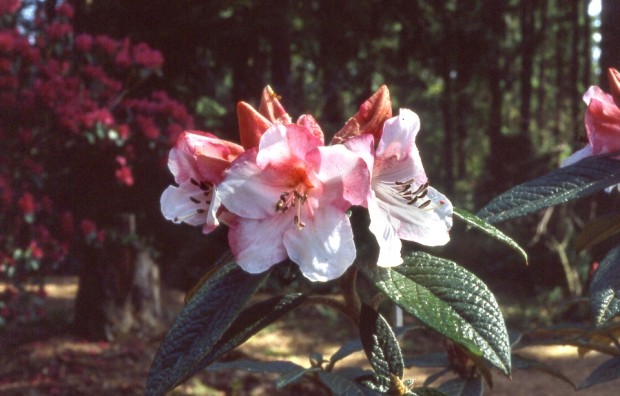
Species rhododendrons are grown for their attractive or fragrant flowers, their interesting and even beautiful foliage, or their smooth and glossy peeling bark. Rhododendron edgeworthii is one of the exceptional species in which all of these desirable characteristics come together.
This species is the best known and most often grown member of subsection Edgeworthia, a small group of lepidote (scaly-leafed) rhododendrons, which also includes pendulum and the rare seinghkuense. These three distantly related epiphytic species are placed together in this subsection because they all possess a feature unique among the lepidotes – a dense woolly indumentum on the young stems and undersides of the leaves.
R. edgeworthii was introduced into cultivation by Joseph Hooker in 1849. He collected this ornamental species in the lush forests of the Himalaya Mountains during his travels through Sikkim. It was named for Mr. M. P. Edgeworth, then the Commissioner of Multan with the Bengal Civil Service. In 1887 a species similar to edgeworthii but with a scaly style and pubescent (hairy) calyx was found by Pere Delavay far to the east in the mountains of northwestern Yunnan Province, China. This plant was given the name Rhododendron bullatum and introduced into cultivation by Scottish plant hunter George Forrest in 1904. It proved to be equally as fragrant and beautiful but substantially hardier than its Himalayan cousin. In 1917 the name R. sciaphyllum was given to a specimen collected by Kingdon-Ward in eastern Myanmar (Burma). Subsequent collections throughout the eastern Himalaya, southwestern China,and northern Myanmar made it obvious that all three “species” merged and that the original collections were just extremes from the edge of the large range of a variable species. Thus, all specimens were reassigned to R. edgeworthii with the names R. bullatum and R. sciaphyllum reduced to synonymy.
Rhododendron edgeworthii is typically found at elevations of 6,000-13,000 feet where it occurs in a wide range of habitats. Rapid drainage at the roots is the common denominator in all situations. It can be quite common on cliffs and rocks in forests but is usually seen as an epiphyte in the tops of large trees and old snags. I have observed this species many times in many different regions during my travels in the Sino-Himalaya. It is often quite common where it occurs, especially in the mountains on either side of the SalweenRiver along the Yunnan/Myanmar frontier. In the lush temperate rainforests of this region, R. edgeworthii is abundant. It is commonly seen hanging from the highest branches of the giant conifers that dominate the high mountain forests in this region, its large flowers seemingly suspended in midair.
The incredibly wide range of this species, both in altitude and geographically, results in tremendous variation in its identifying characteristics. It can be very leggy in habit ranging to relatively compact in some forms. The younger branches are attractively covered with a dense indumentum. While the lower leaf-surface always consists of both scales and the woolly indumentum characteristic of subsection Edgeworthii, leaf shape may vary a great deal. Leaves range from two to six inches long and can be elliptic to oblong-lanceolate or oblong-ovate but always with the distinguishing dark shiny-green bullate (heavily puckered) texture above. The reddish-brown to tawny woolly indumentum completely covers the tiny golden scales on the leaf’s lower surface, yet the upper surface is glabrous (without hair). A superb form that we found colonizing a mass of huge boulders thrust from the surrounding forest on the Shweli-Salween divide in 1997 (CCHH#8016) had the thickest and darkest orange-brown indumentum that we had ever seen. It is a strikingly beautiful form, not only for its stunning foliage but for its very large waxy flowers.
The rose-colored flower buds of Rhododendron edgeworthii open in mid- to late spring to reveal wonderfully fragrant white, white flushed pink or pink flowers, sometimes with a yellow blotch near the base of the tube. Each inflorescence typically contains 2-3 flowers with the individual funnel-campanulate corollas up to three inches in length and up to five inches in diameter. The large and often deeply lobed calyx ranges in color from pink to green flushed with red. It is usually covered with a more or less dense indumentum of silky hairs.
In cultivation, Rhododendron edgeworthii requires similar conditions to those in which it occurs in the wild, with excellent drainage being the most critical factor. When planted in the ground it is a good idea to add generous quantities of coarse organic and mineral material. A sandy soil in a raised bed works well as does a well-rotted old log or stump to mimic the natural epiphytic habitat. With most forms hardy to about 10°F., R. edgeworthii is often grown as a container plant in areas that drop below this temperature with regularity. A very coarse media is essential if the roots are to be restricted in a container. An orchid or vireya growing mix or similar material is ideal to keep the roots healthy. Frequent pinching when young will result in a fuller, more bushy container-grown specimen. When grown in a poorly drained soil, this species tends to develop spotting on the foliage which can become serious enough to defoliate or even kill the plant. Since it is not reliably hardy in all areas it is a good idea to keep a back-up plant or two in case of disaster. Fortunately, it roots readily from cuttings so the lack of bone-hardiness should not prevent anyone from growing this special rhododendron.
Siting is not as critical as drainage but you will tend to get a very leggy plant if planted in too much shade. In full sun you get a bushier specimen but the foliage may burn and the flowers will tend to fade quicker. Light shade from tall coniferous or deciduous trees would be ideal with the added bonus of extra protection from late spring frosts under the conifers. This is one of the few rhododendrons resistant to weevil attack due to the natural production of chemicals in the foliage which repel the adults.
Rhododendron edgeworthii has been used as a parent plant in producing many outstanding hybrids that share its remarkable flowers and fragrance. A few of these include ‘Floral Dance,’ ‘Lady Alice Fitzwilliam,’ ‘Sylvania,’ ‘Fragrantissimum,’and ‘Silver Wedding.’ It has also received a number of awards for its excellent flowers and foliage. A white-flowered form received an Award of Merit when exhibited by T. H. Lowinsky of Sunninghill in 1923 (Farrer#842 as bullatum). A blush pink form (as bullatum) exhibited by Lord Aberconway, Bodnant, in 1946 also received this award. This species has won the prestigious First Class Certificate an astounding three times. This honor was first bestowed in 1933 to a clone with white flowers exhibited by Lt.-Col. L. C. R. Messel, Nymans, and again in 1937 to another white clone shown by Mr. Lionel de Rothschild, Exbury (Forrest No. 26618 as bullatum). The third FCC was awarded in 1981 to clone named ‘Red Collar’ grown from KW#20840 (as bullatum) and exhibited by Loder.
ACCESSIONS IN THE COLLECTION OF THE RSF:
1965/383 (bullatum) Bodnant. Flowers white flushed rose (blush pink) with yellow-green flecks in this 1946 AM form. Our hardiest form.
1973/030 (bullatum) Mossman. Flowers white with some pink. Probably as hardy as 1965/383.
1988/035 KW#20836:Schick
1994/379 CLD#1430:Berkeley B.G. From seed collected in Yunnan at 9,500 feet.
1995/056 (bullatum) F#26618:Exbury:Glendoick. Flowers white in this 1937 FCC form.
NOTE: We also have a couple dozen new accessions grown from seed procured during recent expeditions to eastern Asia. These are currently under evaluation.
REFERENCES CONSULTED:
Cox, Peter A. 1985. The Smaller Rhododendrons. Portland, OR.: Timber Press.
Cox, Peter A., and Kenneth N.E. Cox. 1997. The Encyclopedia of Rhododendron Species. Perth, Scotland; Glendoick Press.
Cox, Peter A. 1993. The Cultivation of Rhododendrons. London: B.T. Batsford, Ltd.
Cullen, J. 1980. “A Revision of Rhododendron. I. Subgenus Rhododendron sections Rhododendron and Pogonanthum.” Notes from the RoyalBotanic GardenEdinburgh. Vol. 39(1).
Davidian, H.H. 1982. The Rhododendron Species (Vol. I, Lepidotes). Portland, OR: Timber Press.
Hootman, S.E. Unpublished field notes. 1995-2006.
Rhododendron Species Foundation: Records – 1964 to present.
Steve Hootman
